Physics 15 Torque (6 of 27) What is a Couple?
TLDRIn this video, the concept of a 'couple' in physics is explored. A couple is defined as two equal and opposite forces acting on a single object, with their lines of action separated by a small distance. Using a 5-meter beam as an example, the video demonstrates how to calculate the torque caused by these forces relative to two different points, A and B. The forces are 100 Newtons downward (F1) and 200 Newtons upward (F2), separated by 50 centimeters. The calculation shows that regardless of the pivot point chosen, the total torque, or 'couple,' remains constant at 50 Newton meters. This torque is calculated by multiplying the magnitude of one force by the distance between the two forces. The video concludes by emphasizing that a couple represents the torque produced by two equal and opposite forces acting on the same object, and its value is independent of the pivot point chosen.
Takeaways
- 🔍 A couple is defined as two forces of equal magnitude but opposite directions acting on a single object.
- 📏 The line of action of the two forces in a couple are separated by a small distance.
- 📍 The concept is demonstrated using a 5-meter long beam with forces F1 and F2 acting on it.
- ⚙️ The torque caused by these forces is calculated relative to two different points, A and B.
- 🔁 F1 causes a clockwise motion (negative torque) and F2 causes a counterclockwise motion (positive torque) about point A.
- 🔄 The sum of the torques about point A equals 50 Newton meters, calculated as -100 N * 3 m + 100 N * 3.5 m.
- 🔃 Similarly, the torque about point B is also calculated, resulting in the same value of 50 Newton meters.
- 🎯 The total torque caused by the couple is independent of the pivot point chosen on the beam.
- ⚖️ A couple is characterized by the torque being equal to the product of the force magnitude and the distance between the forces.
- 📐 The couple in the example is calculated as 100 Newtons * 0.5 meters, equaling 50 Newton meters.
- 🔑 The concept of a couple is important in understanding how forces acting at a distance can produce rotational effects on objects.
Q & A
What is the definition of a couple in the context of forces acting on an object?
-A couple refers to the torque caused on an object by two forces that are equal in magnitude, opposite in direction, and a small distance apart from each other.
What are the two forces acting on the beam in the given example?
-The two forces are F1 acting downward with a 100 Newton force and F2 acting upward with a 200 Newton force.
How long is the beam in the example?
-The beam is 5 meters long.
What is the distance between the lines of action of the two forces in the example?
-The distance between the lines of action of the two forces is 50 centimeters.
What is the torque caused by F1 relative to point A?
-The torque caused by F1 relative to point A is a negative torque, calculated as -100 Newtons times 3 meters, which equals -300 Newton meters.
How is the torque caused by F2 relative to point A calculated?
-The torque caused by F2 relative to point A is a positive torque, calculated as 100 Newtons times 3.5 meters, which equals 350 Newton meters.
What is the total torque about point A caused by the two forces?
-The total torque about point A is the sum of the torques caused by F1 and F2, which is -300 Newton meters plus 350 Newton meters, equaling 50 Newton meters.
What is the torque caused by F1 relative to point B?
-The torque caused by F1 relative to point B is a positive torque, calculated as 100 Newtons times 2 meters, which equals 200 Newton meters.
How is the torque caused by F2 relative to point B calculated?
-The torque caused by F2 relative to point B is a negative torque, calculated as -100 Newtons times 1.5 meters, which equals -150 Newton meters.
What is the total torque about point B caused by the two forces?
-The total torque about point B is the sum of the torques caused by F1 and F2, which is 200 Newton meters minus 150 Newton meters, equaling 50 Newton meters.
Why does the total torque caused by the two forces remain the same regardless of the pivot point chosen?
-The total torque remains the same because the couple is independent of the pivot point; it is determined by the magnitude of the forces and the distance between their lines of action.
How can you find the couple using the magnitude of the force and the distance between them?
-You can find the couple by multiplying the magnitude of one of the forces by the distance between the lines of action of the two forces, which in the example is 100 Newtons times 0.5 meters, resulting in 50 Newton meters.
Outlines
🔧 Introduction to the Concept of a Couple
This paragraph introduces the concept of a couple in physics, which refers to two equal and opposite forces acting on a single object with a small distance between their lines of action. A practical example is given using a 5-meter long beam subjected to two forces, F1 and F2, with magnitudes of 100 Newtons and 200 Newtons respectively. The forces are separated by a distance of 50 centimeters. The main goal of the discussion is to calculate the torque caused by these forces relative to two different points, A and B, on the beam.
Mindmap
Keywords
💡Couple
💡Forces
💡Torque
💡Beam
💡Line of Actions
💡Distance
💡Newton
💡Pivot Point
💡Clockwise and Counterclockwise
💡Magnitude
💡Sum of Torques
Highlights
A couple is defined as two forces acting on a single object with their lines of action a small distance apart.
The concept is explored through a 5-meter long beam with two forces, F1 and F2, acting on it.
F1 is a 100 Newton force acting downward, while F2 is a 200 Newton force acting upward.
The lines of action for F1 and F2 are separated by 50 centimeters.
The video demonstrates calculating the torque caused by these forces relative to two different points, A and B.
For point A, the torque is the sum of negative F1 times distance and positive F2 times distance.
The calculated torque relative to point A is 50 Newton meters.
For point B, the torque calculation involves positive F1 times distance and negative F2 times distance.
The calculated torque relative to point B is also 50 Newton meters.
The total torque caused by the two forces is independent of the pivot point chosen on the beam.
The concept of a couple implies that the total torque remains constant regardless of the pivot point.
A couple is characterized by two forces of equal magnitude, opposite directions, and acting a small distance apart.
The magnitude of the couple can be found by multiplying the force of either one by the distance between them.
The couple in the example is equal to 100 Newtons times 0.5 meters, resulting in 50 Newton meters.
The video emphasizes that the couple is the torque caused by two equal and opposite forces acting on the same object.
The couple can be determined by selecting any pivot point and summing up the torques or by multiplying the force by the distance between them.
The video provides a practical application of understanding torque and force couples in mechanical systems.
Understanding couples is crucial for analyzing the stability and balance of forces in engineering and physics.
Transcripts
Browse More Related Video
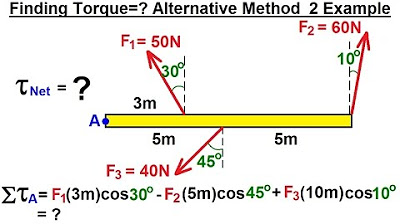
Physics 15 Torque (9 of 27) Alternative Method 1 & 2: Example Torque=?
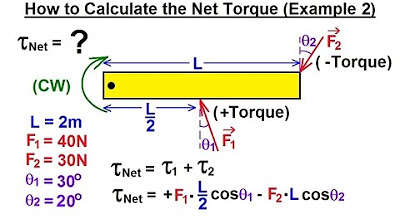
Physics 15 Torque Fundamentals (11 of 13) How to Calculate the Net Torque? Ex. 2
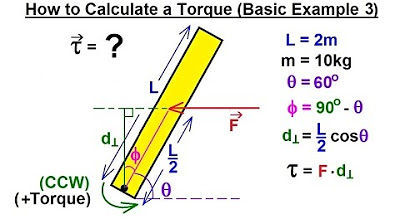
Physics 15 Torque Fundamentals (9 of 13) How to Calculate a Torque (Basic Example 3)
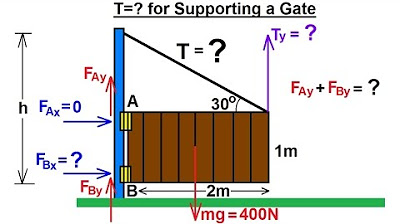
Physics 15 Torque (5 of 27) Tension=? Supporting a Gate
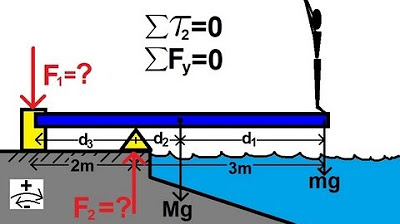
Physics 15 Torque Example 4 (4 of 7) The Diving Board
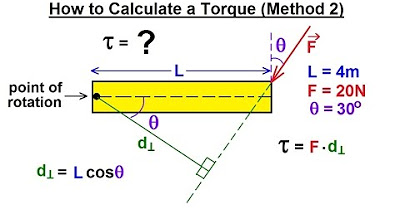
Physics 15 Torque Fundamentals (5 of 13) How to Calculate a Torque (Method 2)
5.0 / 5 (0 votes)
Thanks for rating: